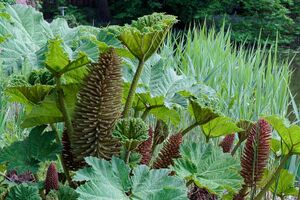Gunnera Cyanobacteria symbiosis: Difference between revisions
No edit summary |
No edit summary |
||
| Line 11: | Line 11: | ||
Cyanobacteria are wide spread around the world, contributing to major global biogeochemical cycles like cellular death <ref> [https://internal-journal.frontiersin.org/articles/10.3389/fmicb.2021.631654/full Aguilera, A., Klemenčič, M., Sueldo, D. J., Rzymski, P., Giannuzzi, L., & Martin, M. V. (2021). Cell death in Cyanobacteria: current understanding and recommendations for a consensus on its nomenclature. Frontiers in Microbiology, 12, 416.] </ref>. | Cyanobacteria are wide spread around the world, contributing to major global biogeochemical cycles like cellular death <ref> [https://internal-journal.frontiersin.org/articles/10.3389/fmicb.2021.631654/full Aguilera, A., Klemenčič, M., Sueldo, D. J., Rzymski, P., Giannuzzi, L., & Martin, M. V. (2021). Cell death in Cyanobacteria: current understanding and recommendations for a consensus on its nomenclature. Frontiers in Microbiology, 12, 416.] </ref>. | ||
== | ==<i>Gunnera</i> and <i>Cyanobacteria</i> symbiosis== | ||
Include some current research, with a second image.<br><br> | Include some current research, with a second image.<br><br> | ||
Revision as of 13:09, 5 November 2021
Gunnera

Cyanobacteria
Cyanobacteria are the largest phylum of Gram-positive prokaryotes on earth. They are known for their ability to obtain energy through photosynthesis [1]. The ability to produce oxygen is believed to be an attribute to their success in evolution because the environment in which they were developing was otherwise occupied by anaerobic bacteria [2].
Many species live in large colonies of cells ranging from hundreds to thousands of cells in a single colony [3]. These colonies are able to form filaments, sheets, or hollow spheres [4]. These colonies, when too large, can form harmful algal blooms that can cause great harm to the aquatic ecosystem and the surrounding area it is in [5].
Cyanobacteria are wide spread around the world, contributing to major global biogeochemical cycles like cellular death [6].
Gunnera and Cyanobacteria symbiosis
Include some current research, with a second image.
Conclusion
Overall text length (all text sections) should be at least 1,000 words (before counting references), with at least 2 images.
Include at least 5 references under References section.
References
- ↑ Sinha, R. P., & Häder, D. P. (2008). UV-protectants in cyanobacteria. Plant Science, 174(3), 278-289.
- ↑ Whitton, B. A. (Ed.). (2012). Ecology of cyanobacteria II: their diversity in space and time. Springer Science & Business Media.
- ↑ Tamulonis, C., Postma, M., & Kaandorp, J. (2011). Modeling filamentous cyanobacteria reveals the advantages of long and fast trichomes for optimizing light exposure. PLoS One, 6(7), e22084.
- ↑ Aguilera, A., Klemenčič, M., Sueldo, D. J., Rzymski, P., Giannuzzi, L., & Martin, M. V. (2021). Cell death in Cyanobacteria: current understanding and recommendations for a consensus on its nomenclature. Frontiers in Microbiology, 12, 416.
- ↑ Paerl, H. W., & Otten, T. G. (2013). Harmful cyanobacterial blooms: causes, consequences, and controls. Microbial ecology, 65(4), 995-1010.(Pearl and Otten)
- ↑ Aguilera, A., Klemenčič, M., Sueldo, D. J., Rzymski, P., Giannuzzi, L., & Martin, M. V. (2021). Cell death in Cyanobacteria: current understanding and recommendations for a consensus on its nomenclature. Frontiers in Microbiology, 12, 416.
Edited by Rachael Tomasko, student of Joan Slonczewski for BIOL 116 Information in Living Systems, 2021, Kenyon College.
